Blue eyes are some of the most popular and rarest colors of eyes in humans, so it’s no surprise that dogs who have blue eyes are popular, too. However, blue eyes are even rarer in dog breeds than humans, since the pigment comes from specific genes or mutations in breedings.
As geneticists mix breeds, more blue-eyed dogs enter the world! Still, only a dozen or so breeds have naturally blue eyes. So, let’s look at the 15 breeds of dogs that have (or can have) blue eyes — as well as what hybrid breeds have blue eyes, the different colors dogs’ eyes can be, and how evolution affects dog eye color.
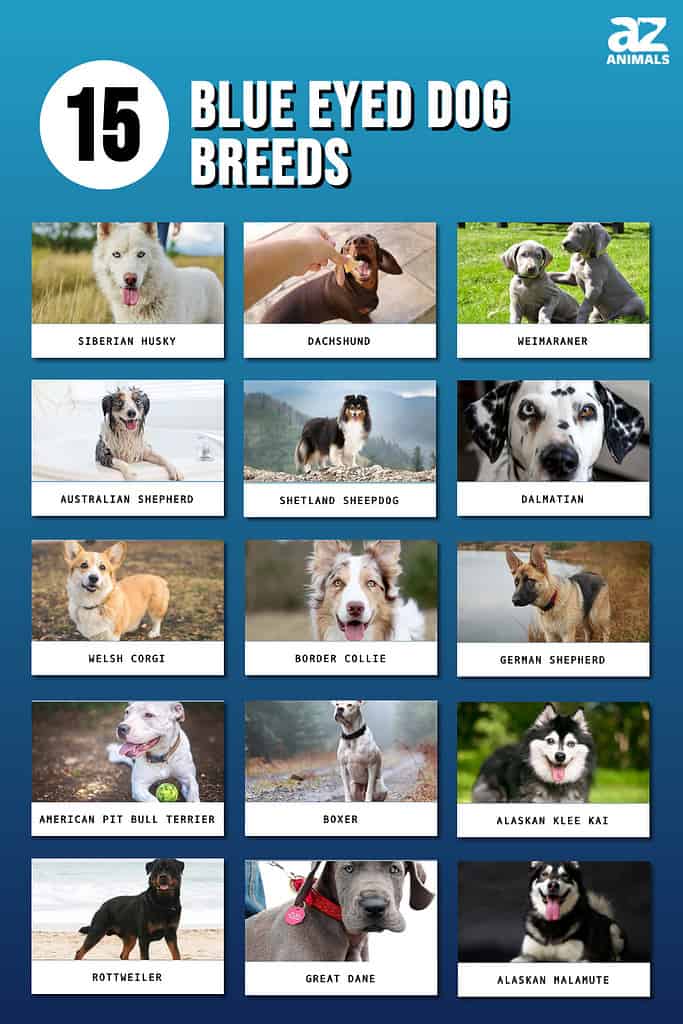
15 Blue Eyed Dog Breeds
A handful of purebred dogs have naturally occurring blue eyes, but they’re still rare. Here are the 15 dog breeds that have naturally blue eyes thanks to a certain coloring, chromosome mutation, or other genetic cause, like the “merle” gene.
Siberian Husky
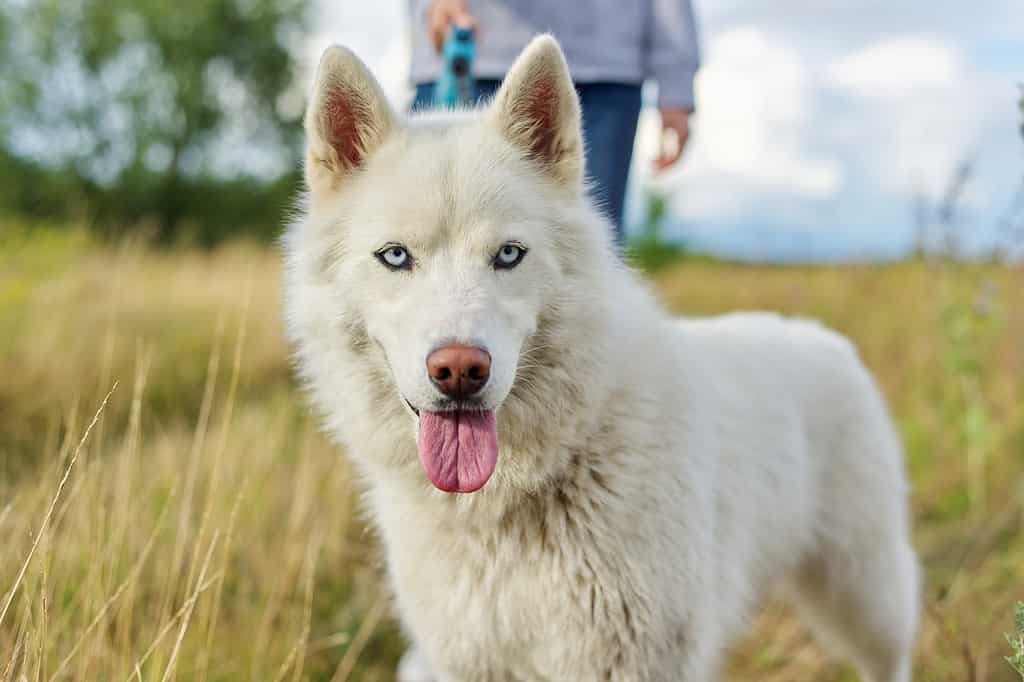
Huskies have naturally blue eyes.
©iStock.com/Valeriy_G
First on everyone’s list for blue-eyed dogs is a Siberian husky. These friendly, intelligent, alert dogs have had ice-blue eyes for generations. Huskies have a reputation for stubbornness along with their need for exercise to throttle their excessive energy.
Recent studies have shown the cause of baby blue eyes in Siberian huskies as a lack of pigmentation and a mutation of the ALX4 canine chromosome. In 2018, a large study of huskies revealed that the breed doesn’t actually carry the merle gene (which often causes odd-colored eyes in dogs) and instead, huskies have a unique chromosomal cause for the lack of pigmentation in their eyes but not coat.
Dachshund

Dachshunds normally have brown eyes, but mutations of blue eyes have occurred.
©Kaczleo/Shutterstock.com
Even rarer than blue eyes, green eyes are seen often in dachshunds for a reason geneticists haven’t found yet. Dachshunds usually don’t have two blue eyes; instead, they have light hazel or heterochromia with one brown and one blue eye.
Bred to find and hunt burrowing animals, the long-bodied dachshund has a lively and clever temperament that keeps owners on their toes. Dachshunds also tend to choose just one of their family to bond closely with and demand that person’s attention and affection.
Weimaraner
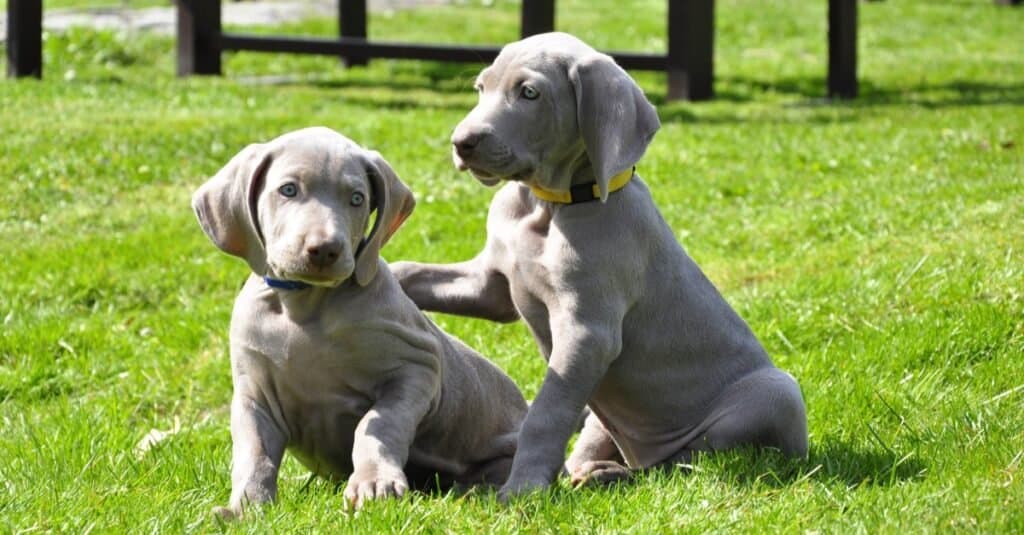
Almost all Weimaraner puppies are born with blue yes.
©applepie agency/Shutterstock.com
Weimaraners like to fake out their breeders and owners — though many Weimaraner puppies are born with blue eyes, the melanin will continue to develop and darken their irises until about three months of life. However, a portion of Weimaraners maintain their unique blue-gray color throughout their lives.
These friendly, courageous dogs are great family pets and maintain a striking appearance, even sans blue eyes, with their sleek fur.
Australian Shepherd

Australian shepherds are energetic working dogs.
©Danielle W Press/Shutterstock.com
The Australian shepherd, along with the husky and border collie, naturally carries the recessive trait of having blue eyes — making them a top pick when mixing breeds. The Aussie’s merle coloring and ice-blue eyes maintain a whimsical, majestic appearance.
Bred as working-class dogs, Aussies need lots of room to let their energy out. Eager to please, easy to train, child-loving, and playful, Australian shepherds make great pets for young, active families who want to adopt their first dog.
Shetland Sheepdog
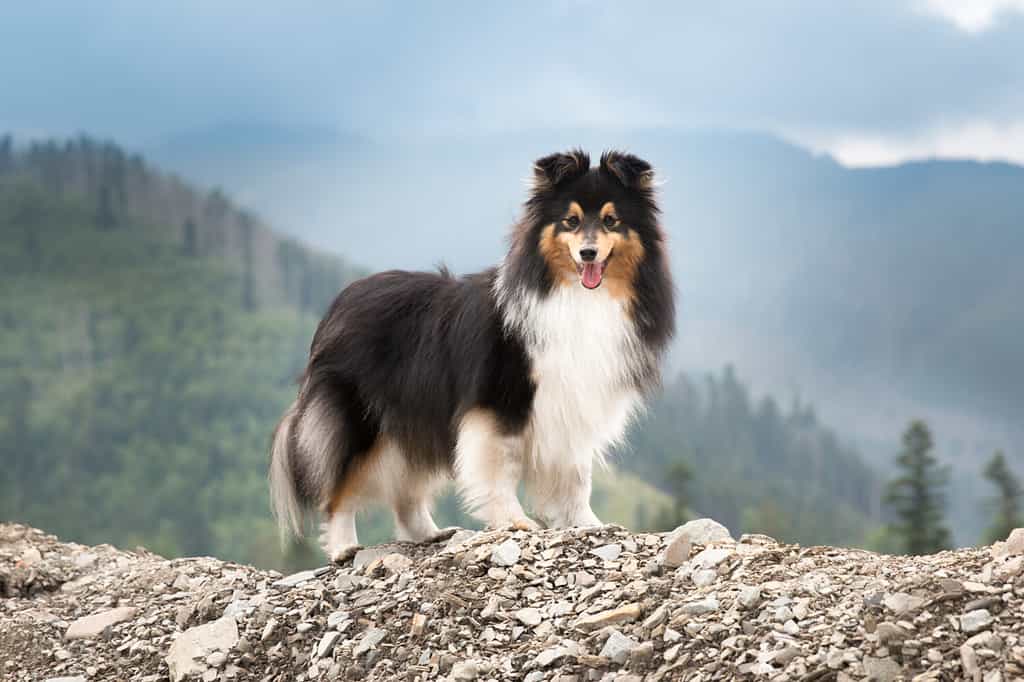
Shelties often have brown eyes, but some have natural blue eyes.
©Lisjatina/Shutterstock.com
With a strong merle gene and being part of the herding group of dog breeds, Shetland sheepdogs (“Shelties”) can and do have naturally occurring blue eyes. This breed encapsulates love; it remains devoted to its family and will show affection through snuggles, playtime, and constant companionship.
Shelties will have blue eyes with a merle coat; otherwise, their eyes will probably be brown or hazel.
Dalmatian

Some Dalmatians have heterochromia.
©iStock.com/Eugen Fedorov
Blue-eyed Dalmatians are rare, but they do exist thanks to the merle gene. Dalmatians have lived in the spotlight for generations, taking center stage in pop culture with Disney’s 101 Dalmatians movie to being the unofficial mascot for fire departments across the nation.
These blue-eyed pups have the unfortunate disadvantage of also having issues with hearing loss — though the direct link between the merle gene, blue eyes, and hearing loss in Dalmatians is unknown. As scientists continue to conduct research, they hope to find more answers for Dalmatians and their parents.
Welsh Corgi

While affectionate and sensitive, corgis also make great watchdogs.
©iStock.com/gorodisskij
Two types of Welsh corgi exist: the Pembroke and the Cardigan. The Cardigan Welsh corgi is the species more apt to have merle coloring, meaning they have a higher probability of having blue eyes. Blue-eyed Pembroke Welsh corgis may have blue eyes, but it is much rarer than their Cardigan counterparts.
Stubborn, independent, and intelligent, the corgi’s small but mighty frame makes it a challenging breed to train but an easy pup to love. Their happy and loving temperament makes them great family additions.
Border Collie
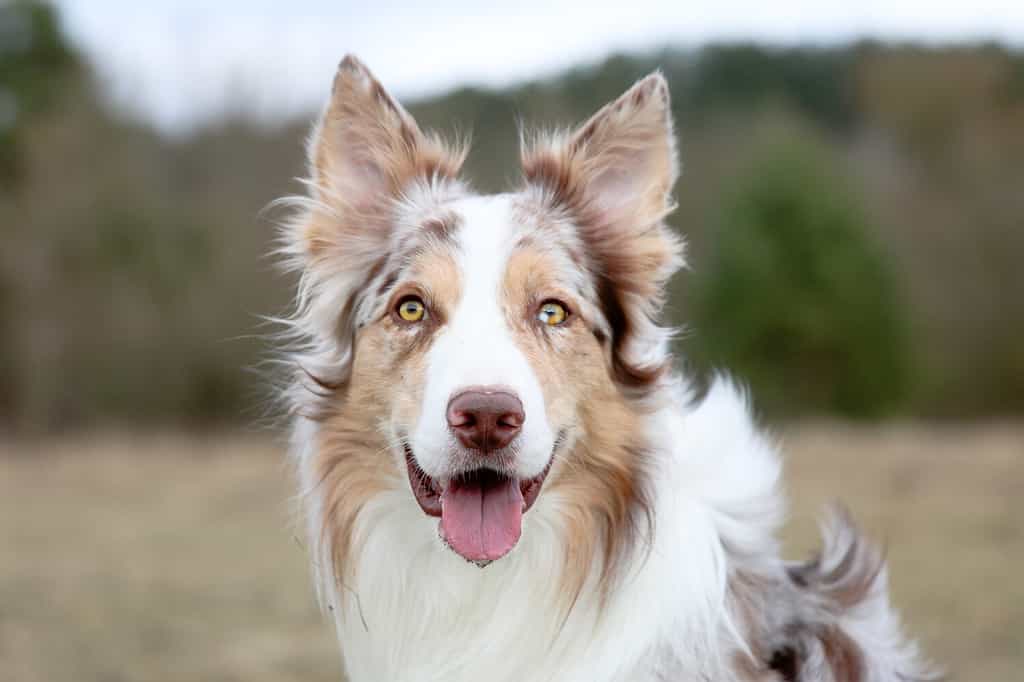
The eyes of a border collie are usually light in pigment.
©Lisjatina/Shutterstock.com
Border collies have naturally light-colored eyes, ranging from blue to gold, to light brown. Blue eyes in border collies are more common in dogs with merle-colored coats because of the amount of pigment in their chromosomes.
With boundless energy and wicked-fast intelligence, border collies often rank as a favorite dog in many “Best Of” lists. They’re best suited to lives with wide open spaces so they have the room to run, play, and work.
German Shepherd
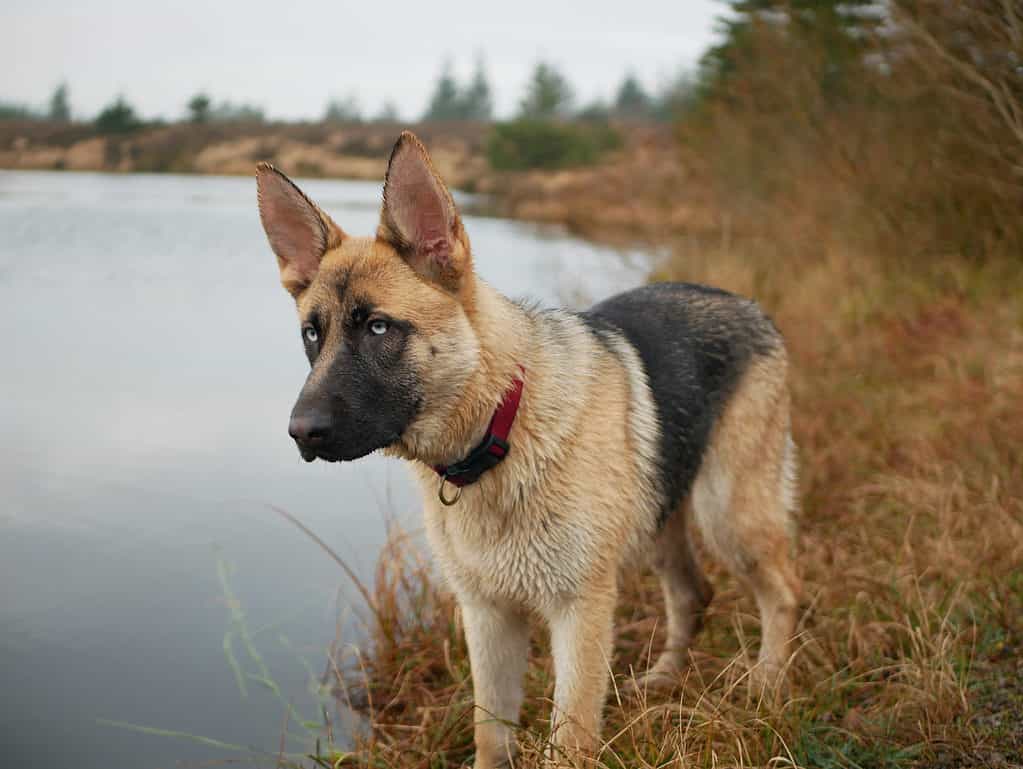
Some German shepherds have blue eyes.
©Alan Malone/Shutterstock.com
German shepherds earned a place on this list through their rare genetic mutations that result in two blue eyes, as well as the heterochromia apparently in some individuals of the breed. A blue-eyed German shepherd remains incredibly rare and often is thought to have been mixed with a husky to obtain a blue eye color.
German shepherds, loyal beyond measure to their families, are prone to bouts of separation anxiety when away from their loved ones for long periods of time. Overall, they have an intelligent, loyal, and energetic temperament whose protective instincts make them wary of strangers at first meetings.
American Pit Bull Terrier

American pit bull terriers love to play.
©Crystal Alba/Shutterstock.com
While very rare, some genetic mutations have happened to create a blue-eyed American pit bull terrier. Interestingly, while the United Kennel Club and the American Dog Breeders Association recognize the breed, the American Kennel Club does not. American pit bull terriers have tenacious, clownish, and intelligent temperaments.
In some cases, American pit bull terriers with blue eyes are barred from entering official dog shows based on questions of ancestry. Because blue eyes in pit bulls are so rare, officials often call the dog’s purebred lineage into question.
Boxer
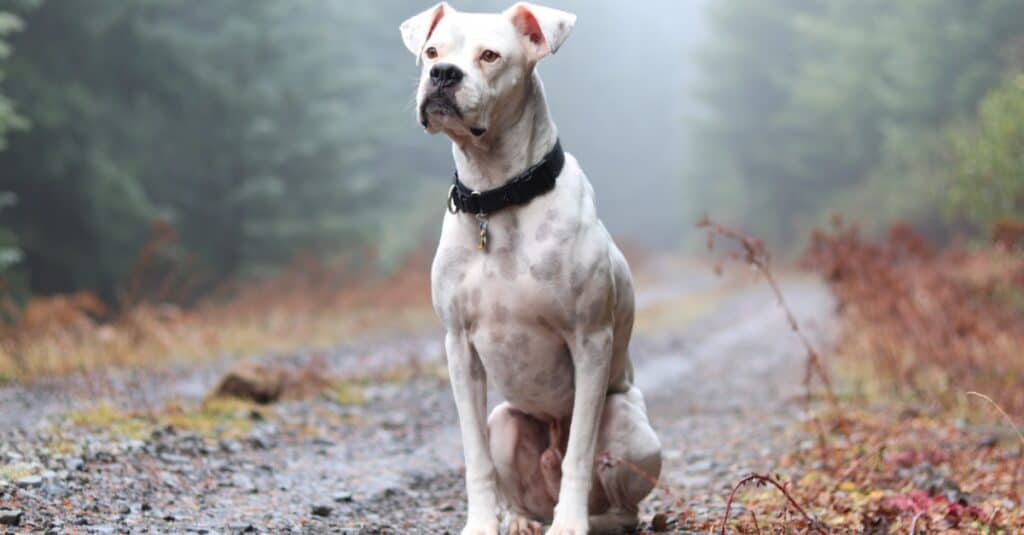
White boxers are thought to have more health problems than those of other colors.
©iStock.com/Amanda Woldt Photography
The boxer’s marking colors affect its eye color, and white boxers have been known to sport one or two blue eyes in the past. While not the norm, these bouncy pups can have striking blue eyes thanks to a lack of pigmentation.
This mastiff-type dog fosters a patient and protective nature alongside their protective and loyal temperament, which makes them great family dogs, especially in homes with young children. They are upbeat, playful, and affable if socialized frequently in puppyhood.
Alaskan Klee Kai
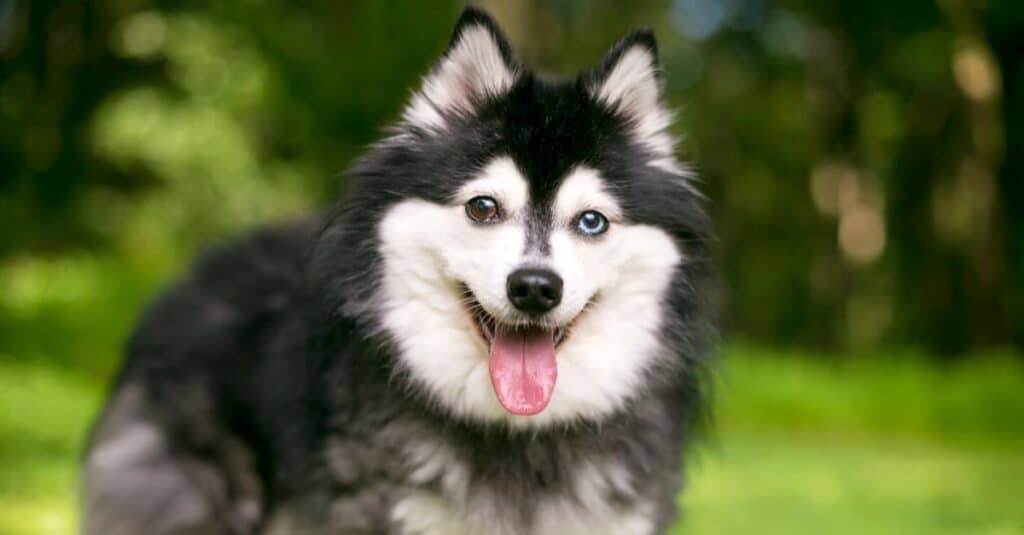
Alaskan klee kais can also have heterochromia.
©Mary Swift/Shutterstock.com
The klee kai is the smaller version of a Siberian husky and is not a recognized breed by the American Kennel Club. Klee kais were bred for companionship, not work, but still have the tell-tale characteristics of their husky cousins — intelligence, energy, and independence.
Like huskies, klee kais are missing the Merle gene and simply have naturally low pigmentation. Many klee kai litters produce a majority of blue-eyed dogs, but klee kais can have brown, hazel, and green eyes as well.
Rottweiler

Based on questionable ancestry, blue-eyed Rottweilers are not allowed to show at national championships.
©cynoclub/Shutterstock.com
Believe it or not, the bumbling, drooly Rottweiler does have blue eyes in some genetic mutations. However, like the American pit bull terrier, Rottweilers with blue eyes are not eligible to be shown at official dog shows based on their questionable ancestry.
This calm, confident breed exudes aloofness to strangers but to their families, Rottweilers are world-class protectors. Originally bred as herding dogs that would double as cart-pullers to meat markets, today’s Rottweilers maintain their stocky build and herding behaviors.
Great Dane
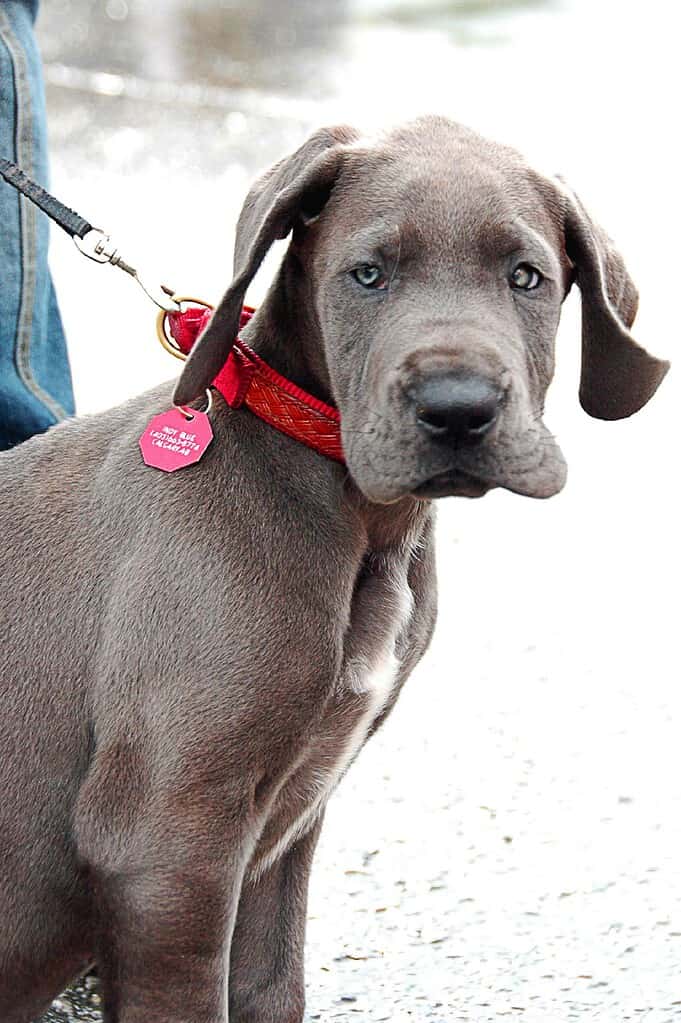
Great Dane puppies often have blue eyes.
©Brian Uhreen / CC BY 2.0 – License
It’s not uncommon for most Great Dane puppies to be born with blue eyes — it’s rarer if the puppy keeps them as they grow into adulthood. Similar to Weimaraners, Great Danes will often develop more melanin as they age, turning their bright blue pigmented eyes to a chocolate brown.
Great Danes are a large breed with a moderately playful temperament and protective natures. If raised with other animals, the Great Dane does fine — but experts warn that certain individuals in the breed may demonstrate aggression to other strangers or animals.
Alaskan Malamute
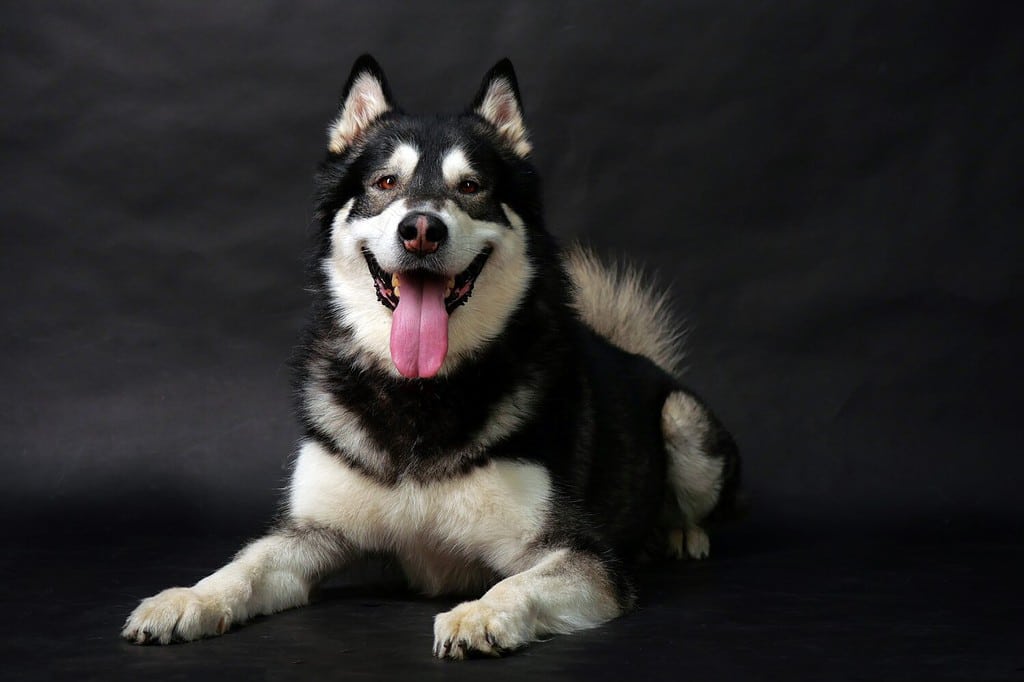
©asadykov/Shutterstock.com
Unsurprisingly, this close cousin of the Siberian husky usually has blue or brown eyes. Some critics of the breed claim that Malamutes with blue eyes are husky-Malamute mixes, but breeders and geneticists have not conducted enough research to approve or reject the claim.
Alaskan Malamutes have maintained their loyal and protective qualities from generations long ago. Originally bred as herders and haulers, Malamutes have a natural curiosity and vigor that promises a lifetime of adventures, love, and protection.
Do Hybrid Breeds Have Blue Eyes More Often?
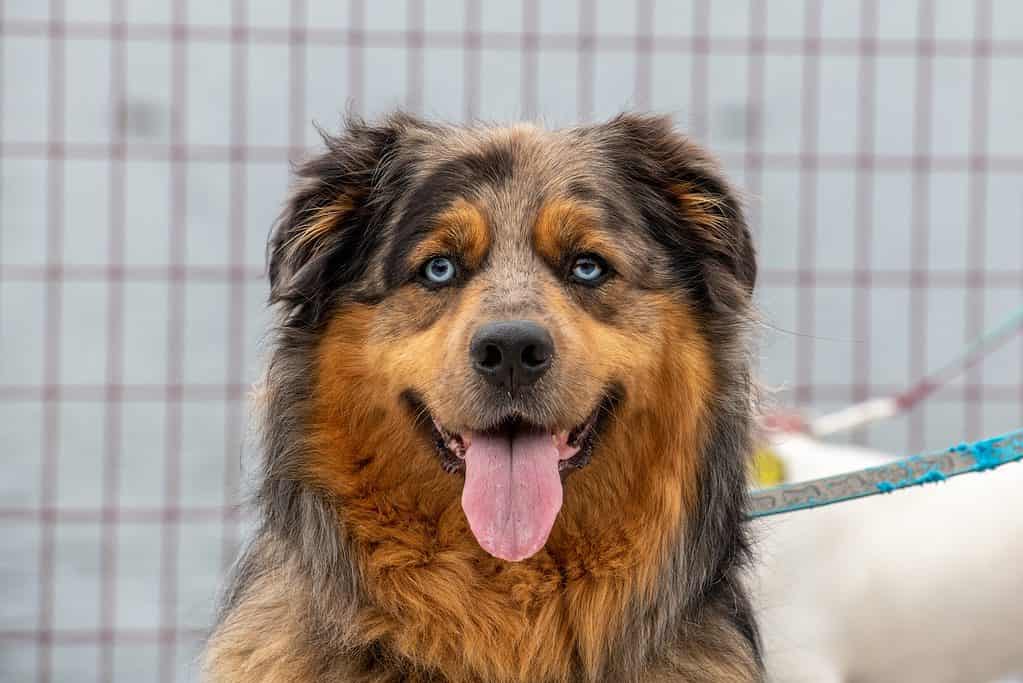
The Australian retriever is a cross between an Australian shepherd and a golden retriever.
©Dolores M. Harvey/Shutterstock.com
Hybrid or mixed-breed dogs don’t have blue eyes in a higher percentage of their populations than purebred dogs, but mixed-breed dogs can and will have blue eyes thanks to at least one of their parents.
Genetics takes chromosomes (which include genes) from both parents to create a new DNA sequence in the child. The reason this might beget more blue-eyed dogs? Having blue eyes is a recessive trait, but if both dog parents have blue eyes, their litter has higher odds of also having blue eyes.
Naturally blue-eyed dogs (like the Siberian husky and the Australian shepherd) and dog breeds that have a proclivity for light eyes (like golden retrievers and beagles) can mix well to produce at least one or two blue-eyed puppies in a litter. Here’s a list of hybrid dog breeds that often have blue eyes.
- Husky Inu (a Shiba Inu/husky mix).
- Aussie Siberian (an Australian shepherd/husky mix).
- Goberian (a golden retriever/husky mix).
- Aussiedoodle (an Australian shepherd/poodle mix).
- Shepsky (a German shepherd/husky mix).
- Border Aussie (an Australian shepherd/border collie mix).
- Horgi (a corgi/husky mix).
- Aussiedor (a labrador retriever/Australian shepherd mix).
What Color Can Dogs’ Eyes Be?
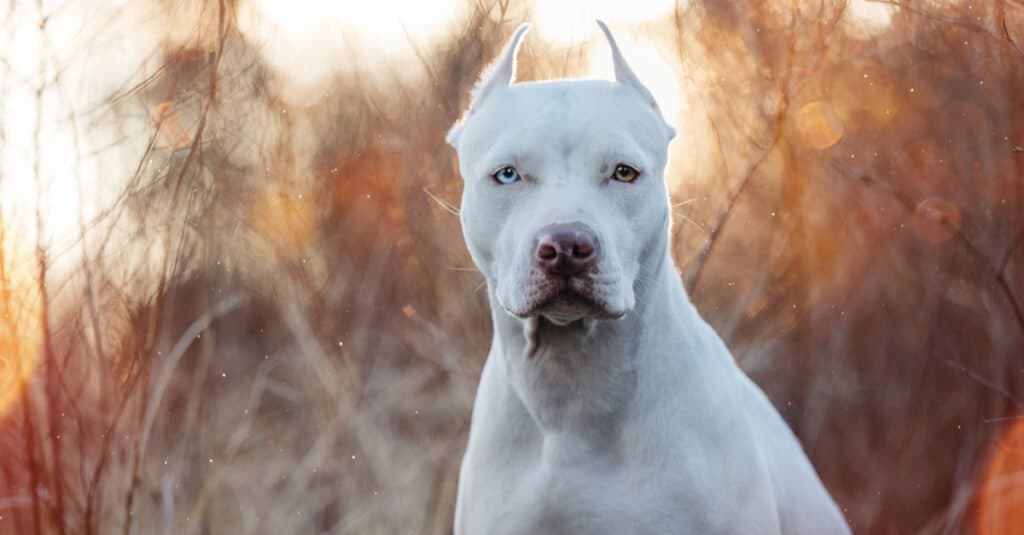
Dog eye colors range from dark brown to light blue.
©OlesyaNickolaeva/Shutterstock.com
Just like humans, dogs can have many different colored eyes. The eye colors in all dogs vary between:
- Brown.
- Golden.
- Hazel.
- Blue.
- Green.
One of the pigments that decides a dog’s (or a person’s) eye color is melanin. Dogs that have more melanin have darker, more brown eyes. Puppies’ eye colors can change, too. Eye color isn’t permanent in dogs until the nine to 12-week mark.
Dog eyes vary in both color and pattern. Speckles, flecks, and striations make each dog’s eyes unique. Some dogs have heterochromia, or each of their eyes is a different color (often it’s a mix of brown and blue) due to a lack of melanin in part or all of one eye.
How Does Evolution Affect Dog Eye Color?
Dogs have come a long way from the first domestication attempt of the species thousands of years ago. Since then, significant evolution has changed dogs’ genetics — including eye color. When dogs were first domesticated and bred, the characteristics owners attempted to save were productivity-related, like the ability to herd or protect. Fast forward to the Victorian Era and dog breeding became much more about aesthetics than a dog’s role on the farm or in the family.
However, the downside to this intentional interbreeding was a loss of genetic diversity and an increase in breed-specific diseases.
Did you know that the dogs mentioned above have different blue eyes based on the pigments in their eyes? Evolution, genetics, and more affect how dogs’ blue eyes develop.
In Siberian Huskies, the eyes of the dogs aren’t actually blue. According to Kristopher Irizarry, a geneticist of the College of Veterinary Medicine at Western University of Health Sciences, huskies’ eyes have a striking “baby blue” appearance because of the way the light enters and reflects in their eyes; the dogs don’t actually have any blue pigments in their eyes. Irizarry likened it to the sky; while on a clear day, the sky above looks blue, the space surrounding the earth isn’t blue. It’s just the way the light interacts with our eyes and the atmosphere — it’s the same concept for huskies.
Furthermore, Diamond Pet described a recent study of dog genetics that resulted in two conclusive markers of blue eyes: a gene linked to the merle color pattern and a gene with a specific position on chromosome 18. These findings help unravel the reason that so few dog breeds have blue eyes.
Blue Eyes Beauties Are Here To Stay
Though few in purebred breeds, blue-eyed dogs most likely won’t lose their striking eyes anytime soon. Enjoy the majestic beauty of these breeds, and keep your eye out for new hybrid or mixed breeds that produce unique colored eye litters.
Summary of 15 Blue-Eyed Dog Breeds and Why They Evolved That Way
| Number | Blue-eyed Dog Breed | Evolution of Blue Eyes |
|---|---|---|
| 1 | Siberian Husky | Lack of pigmentation and a mutation of the ALX4 canine chromosome |
| 2 | Dachshund | Geneticists haven’t found it yet |
| 3 | Weimaraner | Their melanin will continue to develop and darken their irises |
| 4 | Australian Shepherd | Carries the recessive trait of having blue eyes |
| 5 | Shetland Sheepdog | Naturally occurring blue eyes |
| 6 | Dalmatian | Due to the Merle gene |
| 7 | Welsh Corgi | Due to the merle gene |
| 8 | Border Collie | More common in Merle coats due to the amount of pigment in their chromosomes |
| 9 | German Shepherd | Due to the Merle gene |
| 10 | American Pit Bull Terrier | Genetic mutations |
| 11 | Boxer | Lack of pigmentation |
| 12 | Alaskan Klee Kai | Naturally low pigmentation |
| 13 | Rottweiler | Genetic mutations |
| 14 | Great Dane | Low melanin at birth, increases with age and eyes change color |
| 15 | Alaskan Malamute | Not enough research conducted |
The photo featured at the top of this post is © Sergey Bogdanov/Shutterstock.com
Ready to discover the top 10 cutest dog breeds in the entire world?
How about the fastest dogs, the largest dogs and those that are -- quite frankly -- just the kindest dogs on the planet? Each day, AZ Animals sends out lists just like this to our thousands of email subscribers. And the best part? It's FREE. Join today by entering your email below.
Sources
- National Geographic, Available here: https://www.nationalgeographic.com/animals/article/siberian-husky-blue-eyes-study-news#:~:text=Blue%20eyes%20are%20found%20in,the%20blue%20eyes%20to%20occur.
- Wisdom Panel, Available here: https://www.wisdompanel.com/en-us/blog/blue-eyes-in-dogs
- Embark Vet, Available here: https://embarkvet.com/resources/dog-genetics/embark-discovers-why-dogs-have-blue-eyes/
- Spruce Pets, Available here: https://www.thesprucepets.com/dog-breeds-with-blue-eyes-5089039
FAQs (Frequently Asked Questions)
Is it rare for dogs to have blue eyes?
Yes, the trait is quite rare, In DNA testing, we’ve found only about 5% of dogs to have the blue eye variant. Genetic variants may cause only one eye to be blue
Does a blue eye mean a dog is blind?
Are all dogs born with blue eyes?
All puppies are born with blue(ish) eyes because the eye pigment melanin has yet to develop fully. Although this can look very adorable, the color will most likely not stay blue unless their parents also have blue eyes in which case it’s inherited. Most mature dogs actually have brown or green eyes.
Thank you for reading! Have some feedback for us? Contact the AZ Animals editorial team.






